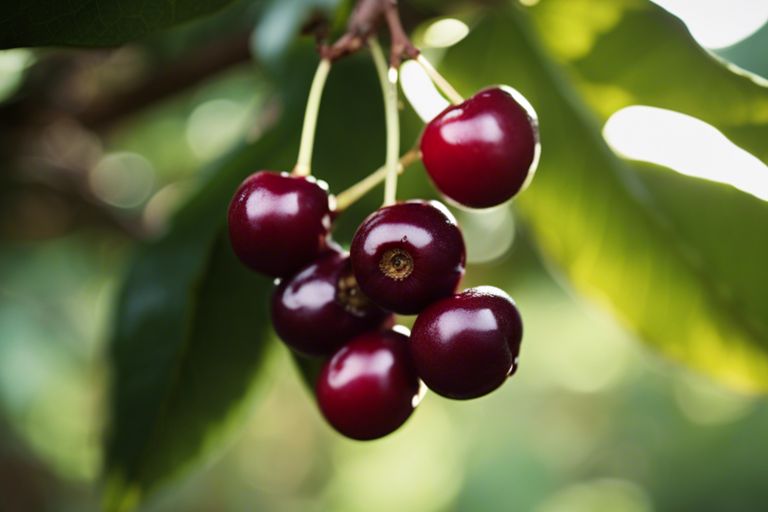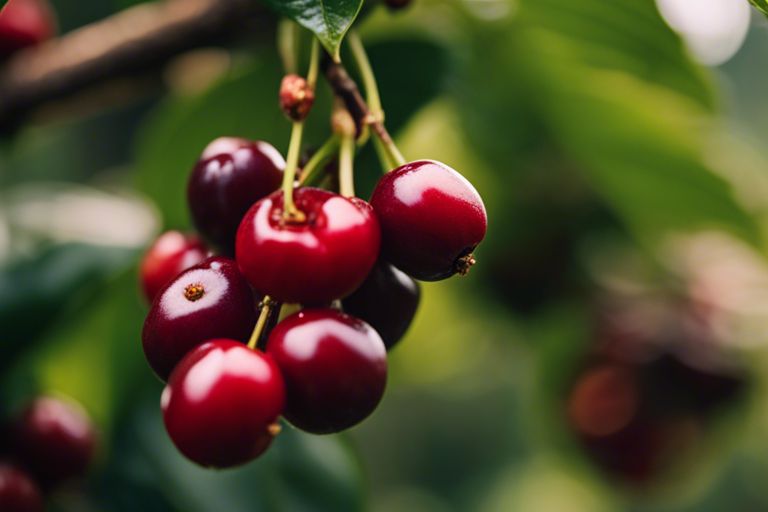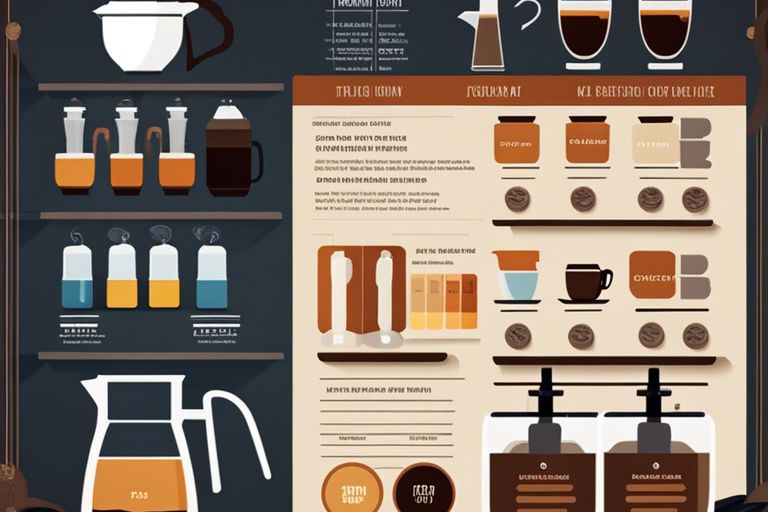Over the years, coffee has become a staple in many people’s daily routine, but have you ever wondered where that aromatic cup of coffee actually comes from? The answer lies in the humble coffee cherry, the fruit that holds the secret to that beloved brew. In this article, we will research into the intricacies of the coffee cherry, exploring its anatomy, flavors, and the journey from the tree to your cup. Join us on an enlightening journey to uncover the origins of your favorite morning pick-me-up.
Key Takeaways:
- Coffee Cherry is the Fruit of the Coffee Plant: The outer layer of the coffee bean that we know and love is actually a fruit known as the coffee cherry.
- Colorful and Flavorful: Coffee cherries come in different colors ranging from red to yellow and can vary in flavor profiles depending on the type of coffee plant.
- Harvesting Process: Coffee cherries need to be harvested at the right time to ensure optimal flavor. This process involves selective picking by hand or strip picking.
- Cascara Tea: In some cultures, the skin and pulp of the coffee cherry are dried and brewed into a tea called cascara, which offers a unique and fruity beverage experience.
- Sustainable Practices: Utilizing the entire coffee cherry, including the pulp and skin, promotes sustainable practices in the coffee industry by reducing waste and creating additional products.
Defining the Coffee Cherry
While coffee is commonly associated with the dark roasted beans that produce our morning brew, its journey begins with a humble fruit known as the coffee cherry. This small, round fruit grows on the coffee plant, known as Coffea, and plays a crucial role in the coffee production process.
Botanical Description
Coffee cherries start as delicate white flowers that bloom on the coffee plant, eventually transforming into green, unripe cherries that mature into a deep red color when ready for harvest. The cherry typically contains two seeds, which are the coffee beans we are familiar with, surrounded by layers of pulp and skin.
Coffee Cherry vs. Coffee Bean
Coffee beans, the seeds found within the coffee cherry, undergo a series of processes to become the beloved beverage we enjoy. After harvesting, the outer layers of the cherry are removed to reveal the coffee bean. The beans are then dried, roasted, and ground to create the various coffee drinks we know and love.
Another notable difference between the coffee cherry and the coffee bean lies in their flavors. While coffee beans can vary in taste depending on factors like origin and roasting techniques, the coffee cherry itself has a sweet and fruity flavor profile that is not commonly associated with traditional coffee drinks.


Anatomy of a Coffee Cherry
Exocarp: The Outer Skin
Some coffee cherries have a skin on the outermost layer called the exocarp. This thin and smooth skin is typically red when the cherry is ripe and turns a shade of yellow as it matures. The exocarp acts as a protective barrier for the two layers underneath.
Mesocarp: The Fleshy Pulp
Pulp surrounds the coffee bean, making up the bulk of the cherry. It is juicy and sweet when the cherry is fresh and ripe, often likened to the texture of a grape. This fleshy part of the cherry plays a crucial role in nourishing the coffee bean as it develops.
It is during the processing of coffee that the mesocarp is removed, revealing the beans within. This step is integral to uncovering the flavors that will emerge during roasting and brewing.
Endocarp: The Inner Pith
Anatomywise, the endocarp forms a hard layer around the coffee beans, acting as a final protective barrier. It is a thin, parchment-like covering that envelops each bean. This layer helps to shield the beans from external elements.
With proper processing techniques, the endocarp is carefully removed to expose the green coffee beans that are then ready for roasting. This meticulous process ensures that the beans are ready to develop their unique flavors during the roasting stage.
The Role of Coffee Cherries in Coffee Production
Once again, the coffee cherry takes center stage in the world of coffee production. Harvesting these cherries at the perfect ripeness is crucial to ensuring the quality of the beans. The process of harvesting and processing the coffee cherries is a labor-intensive task that requires attention to detail and precision.
Harvesting and Processing
Production begins with the careful hand-picking of the ripe coffee cherries from the trees. This step is critical as only the reddest and ripest cherries will produce the best quality beans. Once the cherries are harvested, they undergo processing to remove the outer layers and extract the coffee beans inside. This can be done through either the dry or wet processing method, each impacting the flavor profile of the final coffee.
Impact on Coffee Flavor and Quality
Cherries play a significant role in shaping the flavor and quality of the coffee beans. The sweetness, acidity, and overall flavor profile of the coffee are influenced by the ripeness of the cherries when harvested and the processing method used. Additionally, the care taken during harvesting and processing can result in a more consistent and higher quality cup of coffee.
Flavor: The flavor of coffee is greatly impacted by the cherry itself. A perfectly ripe cherry will contribute to a sweet and complex flavor profile in the coffee. On the other hand, underripe or overripe cherries can result in off-flavors or inconsistencies in the final brew.
Coffee Cherry Varieties
Arabica vs. Robusta
With over 100 species within the Coffea genus, Arabica and Robusta are the two main varieties of coffee plants cultivated for consumption. Arabica, known for its delicate flavors and higher acidity, is considered the superior and more complex of the two. On the other hand, Robusta is known for its bold, strong flavor profile and higher caffeine content. While Arabica plants thrive at higher altitudes with ample shade and consistent rainfall, Robusta plants are more resilient and can grow at lower elevations, making them easier to cultivate.
Heirloom and Hybrid Varieties
The world of coffee cherries also includes heirloom and hybrid varieties that offer unique flavors and characteristics influenced by their genetic makeup. Heirloom varieties are traditional cultivars that have been passed down through generations, prized for their exceptional taste profiles specific to certain regions. In contrast, hybrid varieties are created by crossing different coffee plant species to develop plants with specific traits such as disease resistance, yield, or flavor complexity.
The diversity of coffee cherry varieties plays a crucial role in the overall coffee industry, offering a wide range of flavors and experiences for coffee enthusiasts to explore and appreciate.
Understanding Coffee Cherry Varieties
Exploring the different coffee cherry varieties allows coffee lovers to deepen their understanding of the complexities of coffee production and the impact of plant genetics on the final cup. Whether savoring the nuanced flavors of Arabica or the boldness of Robusta, each variety tells a story of its origins and cultivation techniques. By appreciating the diversity of coffee cherry varieties, one can truly embrace the rich tapestry of flavors that the world of coffee has to offer.

The Cultural Significance of Coffee Cherries
For more on the unique uses of coffee cherries, you can check out What is Cascara? | Stumptown Coffee Roasters Blog.
Traditional Coffee Ceremonies
Cherries are an important part of traditional coffee ceremonies in some cultures. In Ethiopia, the birthplace of coffee, a ceremony called the “Coffee Ceremony” is a significant part of their social and cultural life. The ritual involves roasting the green coffee beans, brewing the coffee, and serving it to guests in tiny cups. The coffee cherries are used not only for making coffee but also for their symbolic value in these ceremonies.
Coffee Cherry Symbolism
Ceremonies around the world often attach symbolism to coffee cherries. In some cultures, the red color of the cherry is seen as representing life and vitality. The cherry’s role in the growth cycle, from flowering to fruit-bearing, is seen as a symbol of renewal and prosperity. Additionally, the cherry’s sweet and tangy flavor is sometimes associated with love and affection, making it a popular ingredient in festive drinks and rituals.
Coffee cherries hold a special place in many communities, where they are not only valued for their flavor and aroma but also for the cultural meanings attributed to them. As the fruit that gives us coffee beans, coffee cherries are deeply intertwined with traditions, ceremonies, and symbolism across different parts of the world.
Coffee Cherry By-Products
Many valuable by-products can be derived from the coffee cherry, making the coffee production process more sustainable and reducing waste. Two popular by-products of coffee cherries are Coffee Cherry Tea and Coffee Cherry Flour.
Coffee Cherry Tea
Byproducts of coffee cherries can be used to create a delicious and unique beverage known as Coffee Cherry Tea. This tea is made from the dried skins of the coffee cherry fruit and offers a fruity, slightly sweet flavor with hints of floral notes. Rich in antioxidants and caffeine, Coffee Cherry Tea is gaining popularity for its health benefits and sustainable production methods.
Coffee Cherry Flour and Other Uses
To further minimize waste and maximize the benefits of coffee cherries, the by-products can also be used to produce Coffee Cherry Flour and other useful products. Coffee Cherry Flour is a gluten-free alternative flour that contains high levels of fiber, protein, and antioxidants. It can be used in baking, cooking, or as a nutritional supplement, adding a unique flavor profile to various dishes.
Coffee Cherry Flour can also be used in skincare products for its antioxidant properties, providing a natural and sustainable alternative to traditional ingredients. In addition to Coffee Cherry Flour, coffee cherry by-products can be used in composting, livestock feed, or even as biofuel, showcasing the versatility and eco-friendly nature of the coffee cherry.
Final Words
As a reminder, a coffee cherry is the fruit that contains the highly sought-after coffee bean within. This small, vibrant fruit plays a crucial role in the coffee production process, as it must be carefully cultivated and harvested to ensure the best possible flavors in your morning cup of coffee. By understanding the journey of the coffee cherry from tree to cup, you can gain a deeper appreciation for the complexity and artistry involved in producing that perfect brew.
Summing up, the next time you take a sip of your favorite coffee, take a moment to think about the humble coffee cherry that started it all. Its journey from tree to cup is a fascinating process that involves meticulous care and skill on the part of coffee farmers. By learning more about the coffee cherry and the effort that goes into producing your daily fix, you can enhance your coffee-drinking experience and develop a deeper connection to the origins of this beloved beverage.
FAQ
Q: What is a coffee cherry?
A: A coffee cherry is the fruit that grows on coffee plants, containing the coffee bean at its center. It starts off as a green fruit and ripens into a bright red or yellow cherry-like berry.
Q: How is a coffee cherry harvested?
A: Coffee cherries are typically harvested by hand-picking to ensure only the ripest cherries are selected. This labor-intensive process requires skilled workers to carefully pluck the cherries from the tree.
Q: What is the taste of a coffee cherry?
A: The flavor of a coffee cherry can vary depending on its ripeness and variety, but it is generally described as sweet and slightly tangy, with hints of floral or fruity notes.
Q: How are coffee cherries processed?
A: After harvesting, coffee cherries undergo processing to extract the coffee beans. This can involve methods like wet processing, where the cherries are pulped and fermented, or dry processing, where they are dried whole before extracting the beans.
Q: What is the environmental impact of coffee cherry production?
A: Coffee cherry production can have both positive and negative environmental impacts. Sustainable farming practices, such as shade-grown coffee and organic cultivation, can help preserve biodiversity and soil health. However, issues like deforestation and chemical use can harm the environment.
Q: Can you eat a coffee cherry?
A: Yes, coffee cherries are edible and can be consumed in various ways. They are sometimes used to make tea or infused into beverages for their unique flavor profile. They are also rich in antioxidants and nutrients.
Q: How does the coffee cherry relate to the final coffee beverage?
A: The coffee cherry plays a crucial role in the production of coffee beans, which are roasted and ground to make the coffee beverage we enjoy. The flavor profile of the coffee cherry can influence the taste of the final brew, making it an important factor in coffee production.

















